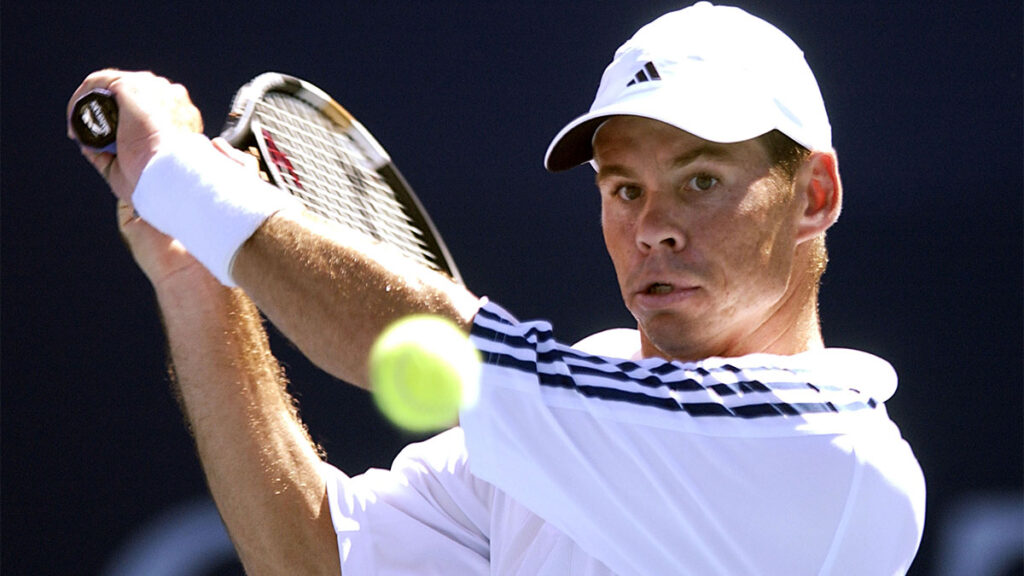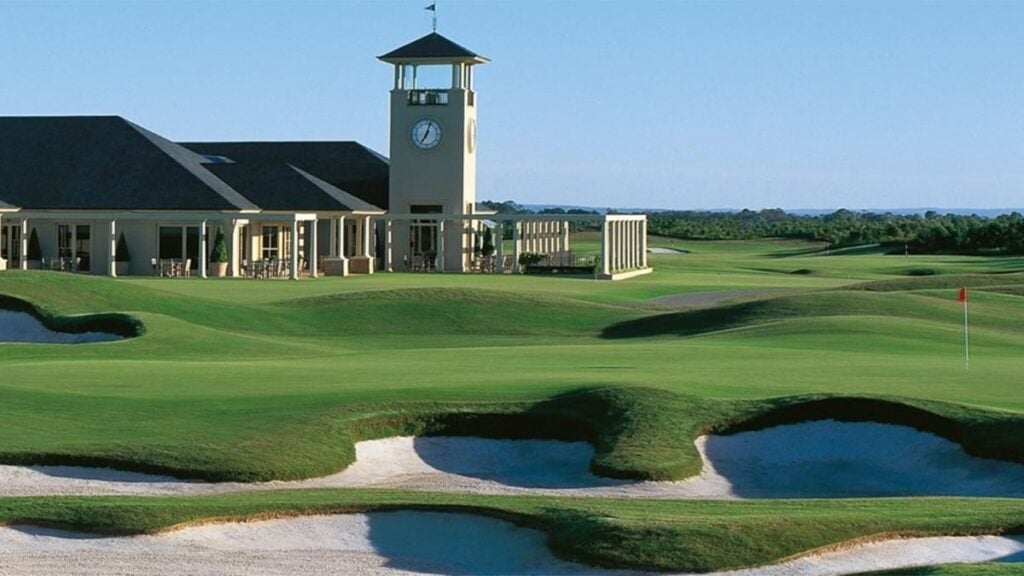Our senior writer reflects on 30 years with Australian Golf Digest.
Never underestimate dedication
The 2003 Masters is remembered for Canada’s Mike Weir becoming the first left-handler to don the green jacket. It’s also regarded as the wettest Masters in history, such was the heavy rain that prolonged the start until Friday.
After sunset on tournament eve, the sunken figure of Padraig Harrington appeared on the practice putting green, hitting putts while his loyal caddie shielded him with an umbrella from the drizzling rain.
Shaking my head in disbelief, I concluded the mad Irishman would never win a single major. And I was right, sort of… Not one, but three major titles (six including senior majors).
▶ ▶ ▶
From the ridiculous to the sublime
The COVID-19 pandemic ushered in the use of face masks, social distancing, PCR tests, hand sanitisers, elbow greetings, quarantining and QR codes. Many people sought refuge on a golf course for the therapeutic benefits of breathing fresh air without the government-enforced mandate of wearing a face mask.
Not A. Lim Kim at the 2020 US Women’s Open. The South Korean wore a face mask the entire week at Champions Golf Club in Houston where she sealed a remarkable victory with a trio of birdies over the final three holes for a one-stroke triumph.
▶ ▶ ▶
The Pymble Crusher
A memorable interview over the journey was a candid chat with Kel Nagle at his home in Balgowlah Heights on Sydney’s northern beaches. The “Pymble Crusher” reflected upon a career that yielded 96 tournament victories, highlighted by his 1960 Open triumph at St Andrews where he pipped the great Arnold Palmer by a single stroke.
Born in 1920, Nagle took up the game at age 16 and reacquainted with it at 25 when he turned professional at the conclusion of World War II after spending four-and-a-half years in the Australian Army. Remarkably, the self-taught late bloomer peaked between ages 39 and 45.
“My dad wanted me to be a carpenter,” Nagle recalled. “I started off to be a carpenter, but I didn’t really like it. And then I went across to Pymble and did a bit of caddieing at weekends to get a bit of pocket money. And then Mr Tom Pop (Pymble professional, Tom Popplewell) was looking for a junior assistant and he gave me a job in the shop. So I practised hard – he showed me the grip and the stance – I worked away to get it going.”
▶ ▶ ▶

The quote* heard around the world
What developed into a controversial interview occurred with Talor Gooch just prior to the 2024 Masters. Despite being crowned LIV Golf’s 2023 individual champion, Augusta National Golf Club chose to overlook the Oklahoman for an invitation to compete at the year’s first major. (Augusta National did invite LIV colleague and Australian Open champion Joaquin Niemann.)
An obvious question was to gauge Gooch’s disappointment. To which he replied if Rory McIlroy won that year’s Masters to complete the career Grand Slam, it would carry an asterisk because some top LIV players weren’t in the field.
That comment provoked international condemnation and caused a meltdown among PGA Tour devotees such as Eamon Lynch and Brandel Chamblee. It even prompted McIlroy to accuse this interviewer – yours truly – to have teased Gooch into making the remark.
Let bygones be bygones, I say. Hence it was wonderful to see McIlroy finally win the Masters in 2025 to complete the career Grand Slam*.
▶ ▶ ▶
Australian golf’s Gallipoli hero
The life of Clyde Pearce remains one of the most incredible yarns Australian Golf Digest has ever published. Sports historian Geoff Armstrong detailed the incredible journey of Pearce, a Tasmanian who – at the age of 20 – became the first native-born winner of the Australian Open in 1908 at Sydney’s Australian Golf Club. That same year Pearce won the Australian Amateur, a tournament in which he was also runner-up on three occasions.
Pearce travelled to Britain for the 1911 Open Championship at Royal St George’s. However by the age of 24 his golf career was effectively over when he migrated to Western Australia to manage a farm with Claude Felstead (the 1909 Australian Open champion). Upon the outbreak of World War I, Pearce volunteered for the army and served in action at Gallipoli. In 1917 Lieutenant Pearce died during the Battle of Messines in Belgium at the age of 29.
▶ ▶ ▶
Courage with a capital C
Most astonishing comeback would be a fitting accolade for Victorian professional Jason Norris, who suffered horrific life-threatening injuries at the 2008 Australian PGA Championship at Hyatt Regency Coolum.
Having attended the ‘Cut Party’ on the Friday evening, Norris grabbed one of the resort’s bicycles to return to his Sunshine Coast accommodation about 1am. In pitch darkness he struck one of those concrete carpark slabs intended to prevent vehicles from reversing backwards and Norris plunged face first into the pavement.
Norris suffered 13 fractures to his lower jaw and lost five teeth. He spent eight weeks eating through a blender. “For at least a month I just wanted to be dead. It was terrible,” he conceded in a forthright interview.
At the time Norris was an accomplished professional who had won the New South Wales Open and West Australian PGA in 2007. But the journey back to full health – let alone professional golf – would be arduous. Adding to his woes, Norris had a degenerative wrist as well as the financial burden from the accident.
Norris not only returned to the fairways, just 14 months later he won the 2010 Victorian Open. Then in 2017 he recorded his finest victory by capturing the Fiji International, which was co-sanctioned by the European and Asian tours. Norris has continued playing competitively and this past summer at the age of 52 he reached a playoff for the Webex Players Series Murray River.
▶ ▶ ▶
The Swilcan Bridge ‘patio’ fiasco
An extraordinary backflip occurred after a roundish stone pad was placed on the entry side to the Swilcan Bridge on the 18th hole of the Old Course at St Andrews in 2023. The new masonry alongside golf’s most iconic bridge formed an elongated ‘Q’. It was an eyesore for golf traditionalists, who went ballistic against its addition on social media platform X, then known as Twitter.
Apparently, the pad was built by the St Andrews Links Trust to protect turf leading towards the Swilcan Bridge due to foot traffic around the famous landmark. But why would the Trust go to such trouble of adding the so-called patio? Photo opportunities for golf tourists who visit the Home Of Golf?
After being brought to public attention, authorities relented just days later, and an excavator was used to demolish the pad. The ultimate submission act.
▶ ▶ ▶
Lydia Ko – a pint-sized teen dynamo
The late Jack Newton used to say golfers from this part of the world entered their prime in the early to mid-30s. Hence it was puzzling to deduce how New Zealand’s Lydia Ko could seemingly master the game in her teens.
In the summer of 2012, Ko won the Women’s NSW Open at Sydney’s Oatlands Golf Club to become the youngest person ever to win a professional tournament, doing so at 14 years of age. The Kiwi became the youngest winner of an LPGA Tour event at 15. And she was the youngest to be ranked world No.1 in professional golf – male or female – when she did so at 17 years, nine months and nine days.
Australia’s Hall of Famer Karrie Webb provided a telling insight into Ko’s meteoric rise and the subsequent influx of younger players into professional golf.
“I think kids are getting taught correctly at a younger age with equipment that fits them. They’re not starting with heavy cut-down clubs. They’ve got clubs that are specifically weighted for someone that’s 7 or 8 years old,” Webb said at the 2013 Women’s Australian Open.
▶ ▶ ▶


Scott Draper – sport’s greatest all-rounder
Scott Draper made the cross-code leap from tennis to golf in spectacular fashion, winning tournaments at the professional level in ambidextrous fashion.
No slouch on the tennis court, left-handed Draper’s finest singles achievement came in 1998 when he triumphed on the grass courts of Queen’s Club in London. On an illustrious honour roll dating back to 1881, Draper’s name is sandwiched between Boris Becker, Mark Philippoussis, Pete Sampras and Lleyton Hewitt.
Tragedy struck the next year when he lost his first wife Kellie to cystic fibrosis. Through the grieving, Draper found solace on the golf course where his natural ability literally came to the fore.
Draper made his professional golf debut as a right-hander at the 2005 Victorian Open. But his appearance that week was overshadowed by playing tennis alongside Sam Stosur in the mixed doubles of the Australian Open and their victory at Melbourne Park.
In February 2007, Draper capped an incredible transition to golf by winning the NSW PGA Championship at Riverside Oaks on Sydney’s outskirts. He closed with a seven-under 65 to win the developmental Von Nida Tour event by a stroke. Three months later, his second wife Jessica gave birth to their son Jayden.
Draper’s short-lived professional golf career came to an end when he retired due to a back injury in 2008. His story would make a great movie script. But the odds of finding an actor with the requisite sporting prowess would have to be a trillion to one.
▶ ▶ ▶
Australia’s residential-golf phenomenon
Golf-course construction in Australia over the past three decades has been driven by the residential-golf boom that had its origins in America. The success of Sanctuary Cove, Hope Island, Lakelands and Glades on the Gold Coast encouraged property developers to invest in golf.
From the turn of the century we’ve seen residential-golf communities built in or near Sydney (Macquarie Links, Twin Creeks, Stonecutters Ridge), Melbourne (Sanctuary Lakes, Eynesbury, Sandhurst, Settlers Run), Brisbane (Brookwater) and Perth (Meadow Springs, Secret Harbour, The Cut, The Vines).
The phenomenon has continued in regional Australia on Queensland’s Sunshine Coast (Noosa Springs, Pelican Waters, Peregian Springs), Victoria’s Bellarine Peninsula (13th Beach), the Murray River (Silverwoods), NSW Central Coast (Magenta Shores, Kooindah Waters) and Hunter Valley (Pacific Dunes, The Vintage, Lovedale Farm).
The phenomenon appears to have peaked due to the exorbitant price of land near Australia’s mainland capital cities, along with a scarcity of sites large enough for a commercially successful development. However, a new trend has emerged. Financially challenged metropolitan golf clubs that own their land are seeking joint ventures with property developers to rezone part of their course for a boutique residential estate. Increasingly, it’s a seniors living community in exchange for a clubhouse refurbishment and course improvements: Sydney’s Cumberland CGC and Chatswood GC with Pariter, Oatlands GC with Levande and Newcastle’s Merewether GC with Thirdi Group.
▶ ▶ ▶


The War On Golf
A disturbing trend to emerge has been what Australian Golf Digest coined ‘The War On Golf’ – a fixation with converting public golf courses into alternative community space. Golf courses leased from a council or utility are most at risk.
A shortage of sporting fields in metropolitan areas (from a lack of urban planning) has been cited as justification for the assault on the sport. However, inner-city zealots such as Sydney Lord Mayor Clover Moore simply wish to replace golf with green space. Moore has long advocated for Moore Park Golf to be reduced from 18 to nine holes.
Courses also targeted in Sydney have been Parramatta (closed), Hudson Park (closed), Warringah, Balgowlah, Cammeray, Gordon, Eastlake, Botany and Marrickville. Melbourne courses under attack include Elsternwick (closed), Kingston Links (closed) and Strathallan.
At the height of absurdity, Sydney’s Wallacia and Carnarvon courses have been identified as potential cemeteries due to the dwindling capacity of existing burial grounds. It’s as if dead people must take priority over the needs of living people.
▶ ▶ ▶
Australian Golf’s Golden Generation
As a country of golfers, Australia has long punched above its weight on the international stage. No more so than in 2006 when Australia had a record eight winners for the PGA Tour season: Geoff Ogilvy (2), Stuart Appleby (2), Adam Scott, Rod Pampling, John Senden and Aaron Baddeley.
This feat was replicated on the PGA Tour in the 2016 calendar year: Jason Day (3), Scott (2), Greg Chalmers, Baddeley and Pampling.
To put this into perspective, Australians won 58 PGA tournaments across 14 years (2004-2017) that spanned Craig Parry’s twilight years on tour to when Cameron Smith burst onto the scene. The Golden Generation is now leaving an impression on the PGA Tour Champions where 10 Australians are entrenched in the top 60 of this year’s moneylist.
▶ ▶ ▶
The Wild Thing Down Under
Attracting world-class golfers Down Under has been problematical ever since the United States PGA Tour extended its schedule to the whole calendar year. In the 1990s and 2000s we were blessed to have two-time Major winner John Daly as a staple of Australia’s summer of golf.
Long-hitting Daly was compelling viewing whether hungover or sober. At the 2002 Australian PGA at Coolum, Daly threw his putter into the water hazard on the 18th hole after making a triple-bogey 7 and was disqualified after refusing to sign his card. At the 2008 Australian Open at Royal Sydney, Daly was given a suspended fine by Golf Australia for breaking a spectator’s camera. At the 2011 Australian Open at The Lakes, Daly walked off during his first round after putting seven balls into the water on the par-5 11th hole.
A special thanks to tournament promoter Tony Roosenburg (and Crown Casino) for availing us of Daly’s presence so often.
▶ ▶ ▶
Golfers As Athletes
The old stereotype of pot-bellied professionals no longer exists. Australia has led the way in golf’s physiological transformation through trailblazers such as the late physiotherapist Ramsay McMaster. To illustrate ‘Golfers As Athletes’, Australian Golf Digest undertook a photoshoot on the Melbourne Cricket Ground for a feature that appeared in our October 2005 issue.
Today, elite amateurs in state and national programs undergo a postural and skeletal assessment to identify muscle imbalances prior to any swing change. A three-dimensional biomechanical analysis is performed before a sequence of golf-specific exercises is prescribed to complement the intended swing changes.
These ‘screenings’ have become a keystone of maximising a golfer’s potential as well as reducing long-term injury. With Australians at the forefront, golf-specific training has been embraced around the world and led to outstanding progress from golfers in non-traditional markets of Europe and Asia.
▶ ▶ ▶
One Of A Kind – Peter Thomson
Those fortunate enough to know Peter Thomson would testify he possessed a dry sense of humour. Legend has it a swashbuckling professional invited Thomson to his wedding – to which the five-time Open champion apparently wrote: “My apologies. I have another engagement. I’ll come to the next one.”
To commemorate the 50th anniversary of Thomson’s first Open Championship, I had the pleasure of interviewing the great man. At one stage I sheepishly enquired as to why the Americans failed to dominate The Open in the 1950s and 1960s to the degree we’ve come to expect. Thomson replied – deadpan – in the plummiest of accents: “Because I was there.”
Thomson could be self-deprecating for all his achievements. The conversation turned to a decorative wine range to celebrate Thomson’s five Opens. The label recorded his results: T6-2-T2-1-1-1-2-1-1-DNF-T9-7-T6-5-DNF-1-T8-T8-DNF…
This was before the internet held comprehensive records about professional golf tournaments. Rather sheepishly again, I enquired about DNF. Certainly, he finished the golf tournament?
“Did Not Feature,” came the blunt reply.
Main Photograph: getty images: chris mcgrath



